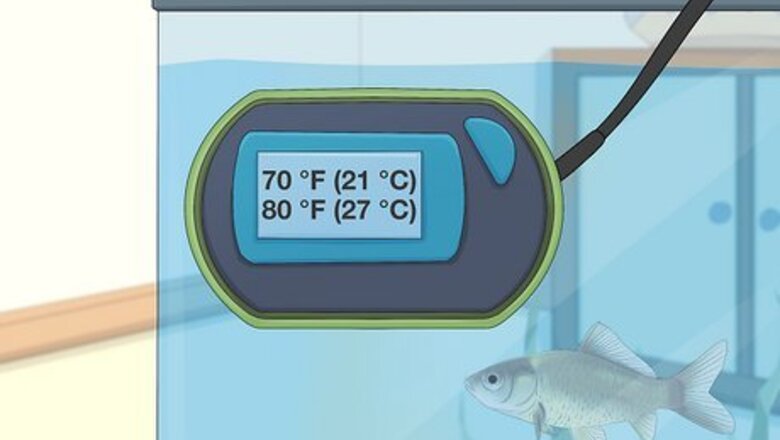
views
- To treat swim bladder disease, let the fish fast for 3 days to give them time to digest their food.
- Then, feed them a soft, cooked, peeled green pea in small pieces once a day for a week until you see their symptoms improve.
- If a goldfish has swim bladder disease, they’ll likely have trouble floating, sinking, or staying level while swimming.
Treating Swim Bladder in Goldfish

Raise the water temperature in the tank. Cold water can slow digestion and lead to constipation. While treating your goldfish's swim bladder disorder, keep the water temperature between 70 °F (21 °C) and 80 °F (27 °C) to aid digestion. Use an aquarium heating pad to heat a smaller tank, or opt for a probe heater if you have a larger tank. Keep an aquarium thermometer in your fish tank to monitor the temperature 24/7.
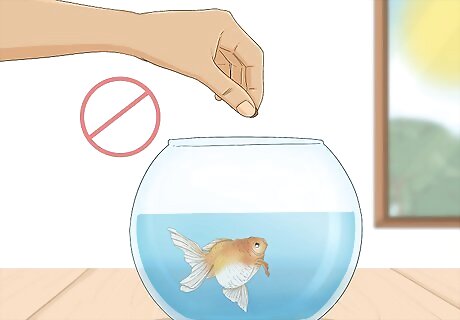
Let your fish fast for 3 days. Since swim bladder disorder is commonly caused by eating problems, stop feeding your fish for 3 days. When fish overeat, they can end up with enlarged internal organs, causing the swim bladder to be compromised. Give the fish a chance to digest the food that they’ve already eaten so their stomach, intestines, and other organs can shrink back to a normal size. Fasting for 3 days should not negatively affect your fish. However, do not continue the fast for more than 3 days. During the fast, observe your fish to see whether the swim bladder disorder seems to have gone away. If the fish still exhibits symptoms, move on to the next step.

Feed cooked peas to your goldfish. Peas are high in fiber and can help ease a fish's constipation problems. Buy a package of frozen green peas and cook them until they’re soft (either in the microwave or on the stove). Remove the peel from a pea and drop a few small pieces of the peeled vegetable into the water. Only give your fish 1 or 2 peas per day. Avoid overcooking the peas; if they're too mushy, they'll fall apart before the fish can eat them. Fish often gulp too much air when they eat flake food, causing indigestion and organ enlargement. Feeding them dense peas fixes this problem.
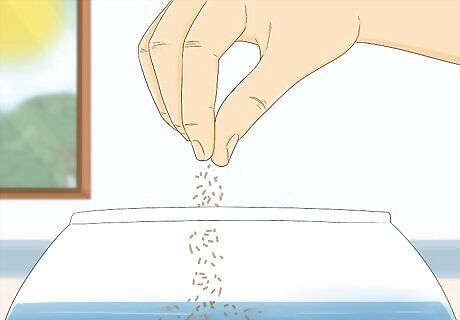
Feed your fish by hand if necessary. When you drop a bit of pea into the water, it may sink to the bottom of the tank. Fish with swim bladder disorder may have trouble swimming to the bottom to reach the food. If necessary, hold the pea on the water's surface until your fish can move close enough to eat it. Alternatively, try skewering a pea on a toothpick and holding it out to your fish, or lower the water level so your fish can reach the pea at the bottom of the tank.

Resume the regular diet and schedule if your fish's symptoms improve. After a few days on a peas-only diet, your fish's digestion should start returning to normal—they should swim without problems. At this point, start feeding your fish regular fish food again. If symptoms persist, the fish may have an untreatable problem, such as an organ deformity or internal damage. Give it a few more days to see if the symptoms of swim bladder disorder go away. If your fish never regains the ability to swim and eat properly, contact a veterinarian or aquarium specialist.
Preventing Swim Bladder Disease

Soak food before feeding your goldfish. Flaky fish food floats at the top of the water, so when fish take a bite, they also gulp down some air. This can cause their organs to become enlarged, leading to swim bladder disorder. Try soaking fish food in a cup of tank water for 5 to 15 minutes before giving it to your fish. This way, the food will sink into the water, allowing your fish to eat without taking in air. Alternatively, purchase sinking fish food that automatically sinks to the bottom of the tank without needing to be soaked. If you feed your fish anything besides flakes or pellets, make sure it's nutrient dense and fully thawed before feeding.

Feed goldfish a small amount 2-4 times a day. When fish eat too much, they can become constipated, leading to intestine or stomach enlargement and swim bladder problems. Only feed your fish the amount of food they can eat in 2 minutes or an amount that’s roughly the size of their eye 2 to 4 times a day. Even if your fish seems like they’re always hungry, they only need a small amount of food to stay healthy.

Keep your fish tank clean. A dirty tank harbors bacteria and parasites, putting strain on a fish's symptoms and sometimes leading to infection. Aim to clean your goldfish’s tank every 2 weeks, changing 25% of the water each time. Changing the water doesn't guarantee it's optimized for your fish, especially if you have never tested your water since starting your tank. Use a water test kit to check pH, ammonia, and nitrite levels. Goldfish do best in water with 0% ammonia, a pH level between 7.2 and 7.6, and a nitrate level between 0 and 0.25 ppm. Try adding ⁄2 tsp (0.083 fl oz) of freshwater aquarium salt to every 1 US gal (3.8 L) of tank water to help prevent disease and boost your goldfish's immune system.
Symptoms & Causes of Swim Bladder Disorder
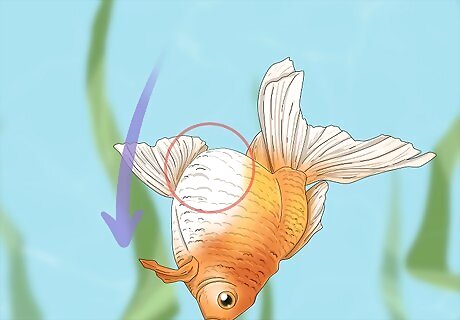
Symptoms: floating, sinking, or bloated stomach Swim bladder disorder occurs when a fish's swim bladder, which normally inflates and helps the fish stay properly afloat, becomes compromised. The symptoms are usually the same, no matter what's causing the problem. When you see your fish belly-up, don't assume it's dead; if it's still breathing, it probably has swim bladder disorder. Here are symptoms to look for: The fish keeps floating to the top, upside-down The fish keeps sinking to the bottom of the tank The fish swims with its tail higher than its head (this is normal for head-standing fish species) The fish has a swollen belly

Causes: eating too much or too fast When a fish's tiny organs swell, they can press against the swim bladder and cause it to malfunction. The stomach, intestines, and liver are especially prone to becoming enlarged due to a fish's eating habits. Any of the following can cause swim bladder disorder: Gulping too much air while eating, causing the stomach to become enlarged Eating low-quality or air-filled food, causing constipation in the intestine Eating too much, causing fatty deposits to enlarge the liver The development of cysts in the kidney, causing it to become enlarged Deformity of an internal organ
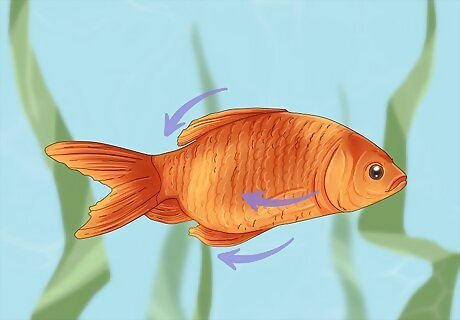
Signs of infection: lack of appetite, shaking, and clamped fins Sometimes swim bladder disorder is a symptom of infection. If this is the case, you won't be able to treat the disease by changing your fish's eating habits. If you believe that your fish has an infection, it's important to treat that separately to help your fish get healthy again. If your fish has an infection, they’ll likely exhibit clamped fins, shaking, and lack of appetite in addition to other symptoms of swim bladder disorder. Start by cleaning the tank to reduce bacteria levels; in many cases, this will kill the bacteria causing the infection. If symptoms persist, consider treating the fish with a broad-spectrum antibiotic to cure the infection (with a veterinarian’s guidance). Be sure to follow the instructions on the packaging to not over-medicate your fish.

Most susceptible to swim bladder disease: goldfish and betta fish These fish have round, short bodies, which causes their organs to become compressed. The fish's internal organs can press against the swim bladder, making it difficult to function properly. If you have a fancy goldfish or a betta fish, monitor them carefully for signs of swim bladder disorder. Left untreated, it can lead to death. Natural goldfish varieties with longer bodies are less prone to getting swim bladder disorder since their organs are not packed tightly together.

















Comments
0 comment